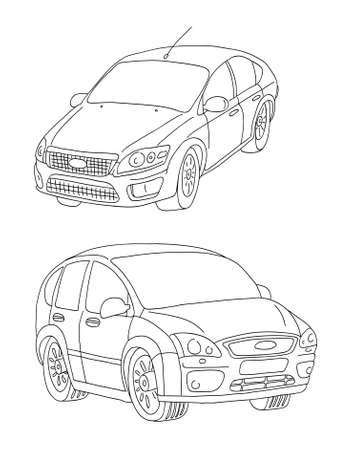Introduction: Navigating Change in the Modern Dashboard
There’s something undeniably special about sliding behind the wheel of a classic American car—the satisfying click of chrome-trimmed buttons, the tactile twist of a well-worn radio dial, and the reassuring feel of sturdy knobs beneath your fingertips. For decades, these analog controls were more than just functional; they were part of the soul of American driving, connecting us to our vehicles and the open road in a uniquely hands-on way. Fast forward to today’s showrooms, and you’ll find dashboards transformed by sleek touchscreens that offer dazzling digital displays and endless customization options. This evolution from physical buttons to digital interfaces marks a crossroads in automotive design, stirring up passionate debates among drivers who cherish the craftsmanship of yesteryear and those eager for the seamless convenience of modern technology. As we dive into the pros and cons of touchscreens versus physical buttons, let’s take a nostalgic journey through this shift—honoring the heritage of classic controls while exploring what’s gained (and sometimes lost) in our quest for innovation.
2. The Allure of Touchscreens: Sleek Looks and Expansive Features
Theres no denying the magnetic pull of touchscreens in today’s vehicles. Their glassy, seamless surfaces evoke a sense of futuristic luxury that resonates with American drivers who grew up on smartphones and tablets. The familiar swipe, tap, and pinch-to-zoom gestures make modern infotainment systems feel second nature—like your favorite device, but built right into your dashboard.
The Smartphone Effect
Touch-based interfaces have fundamentally changed how people interact with their cars. Instead of rows of physical buttons and knobs, sleek digital displays now offer customizable layouts, vibrant graphics, and interactive menus. This isn’t just about aesthetics—its about personalizing the driving experience. Want to rearrange your icons or switch between navigation and media? With a touchscreen, it’s all at your fingertips, echoing the app-centric culture that defines American tech life.
How Touchscreens Are Transforming Vehicle Interaction
| Touchscreen Features | Impact on American Drivers |
|---|---|
| Customizable Home Screens | Drivers can prioritize frequently used functions, mirroring smartphone layouts for quicker access. |
| App Integration (Apple CarPlay/Android Auto) | Seamless connectivity allows easy access to music, maps, and messaging—keeping life moving even on the go. |
| Advanced Climate & Comfort Controls | Adjusting temperature or seat settings becomes as easy as swiping through options rather than fumbling for dials. |
| Dynamic Updates & Over-the-Air Improvements | Infotainment systems stay current without a trip to the dealership, reflecting the ever-evolving nature of U.S. technology trends. |
Touchscreens: A New Standard for Modern Drivers?
The rise of touch-based controls is more than just a passing trend—it’s a reflection of how Americans expect their vehicles to fit seamlessly into their digital lives. As car interiors become more connected and customizable, touchscreens are redefining what it means to be behind the wheel in the 21st century.
![]()
3. Why We Still Love Buttons: Tactile Satisfaction and Intuitive Use
There’s something undeniably comforting about the classic feel of a physical button or rotary knob beneath your fingertips—a sensation that touchscreens just can’t replicate. For generations, American drivers have relied on the sturdy craftsmanship of well-made controls, from the solid click of a volume dial to the reassuring snap of a climate control switch. These tactile interfaces aren’t just nostalgic reminders of driving’s golden age; they offer genuine ergonomic advantages that many still crave today.
On the open road, where attention should be fixed firmly ahead, physical buttons allow you to operate your car’s infotainment system almost by muscle memory. You don’t need to take your eyes off traffic to adjust the radio or tweak the AC—just a quick reach and a familiar twist or press, and you’re back to enjoying the drive. This intuitive use is especially valuable when navigating busy highways or winding country routes, where every distraction matters.
The beauty of these controls lies in their timeless design and the sense of direct connection they provide between driver and machine. Whether it’s the knurled metal of a vintage volume knob or the satisfying resistance of a mechanical switch, these details celebrate decades of automotive craftsmanship. For many enthusiasts, these tangible elements are more than just functional—they’re part of what makes driving an experience rather than just transportation.
In an age where sleek touchscreens dominate dashboards, there’s still a strong case for the classic button. It’s about confidence, ease, and that irreplaceable feeling when everything clicks into place—literally.
4. Safety and Usability: Keeping Eyes on the Road
When cruising down Route 66 or weaving through Los Angeles traffic, the last thing you want is an infotainment system that pulls your focus away from driving. The debate between touchscreens and physical buttons comes to a head when we consider distractions, muscle memory, and real-world usability across Americas vast highways and bustling city streets.
Distractions: Glance Time Matters
Touchscreens can be visually impressive, but they often demand more of your attention—requiring you to look away from the road to find and select functions. Physical buttons, in contrast, offer tactile feedback that lets you keep your eyes forward, relying on feel instead of sight. This distinction becomes even more critical at high speeds or in dense urban traffic where split-second decisions matter.
Muscle Memory: The Forgotten Art
Theres a certain nostalgia in reaching for a familiar volume knob or climate control button without thinking—something American drivers have grown up with for generations. Physical buttons let muscle memory take over; after a few drives, you instinctively know where each function lives. Touchscreens, however, tend to shuffle icons with software updates, making it harder to build those reflexes.
Real-World Driving Conditions: A Comparative Table
| Scenario | Touchscreen Experience | Physical Button Experience |
|---|---|---|
| Bumpy rural roads | Difficult to tap accurately; eyes off road longer | Easy to locate by feel; quick adjustments |
| Nighttime driving | Glare and brightness issues; searching for icons | Consistent location; backlit controls are easy to find |
| Heavy city traffic | Multiple taps needed for simple tasks; increased distraction risk | Single press or twist gets the job done swiftly |
| Cold weather/gloves on | Sensitivity drops; may not register touch inputs | No loss of functionality; gloves work fine with buttons/knobs |
The bottom line? While touchscreens offer modern flair and flexibility, physical buttons provide reliability, predictability, and safety—especially when every second counts on America’s roads. For many drivers raised on classic craftsmanship, theres still unmatched peace of mind in feeling a click beneath your fingertips while keeping your eyes fixed on the journey ahead.
5. Maintenance, Longevity, and Cost
When it comes to the nuts and bolts of infotainment systems, there’s more than just sleek looks and fancy touch controls to consider. Let’s roll up our sleeves and weigh the practical factors: Which interface—touchscreens or physical buttons—is built to last, and which might leave you making an extra trip to the mechanic (or opening your wallet wider) as the years go by?
The Durability Factor
Physical buttons have a long-standing reputation for reliability. Think of that old Chevy radio knob you could twist a thousand times—a classic piece of engineering that rarely let you down. Buttons and dials are tactile, mechanical components designed to withstand repeated use, even from generations of fidgety fingers or gloved hands on a frosty Midwest morning.
Touchscreens, on the other hand, rely on glass panels, sensors, and sophisticated circuitry. While they offer clean lines and modern appeal, they’re not immune to scratches, smudges, or the occasional cracked screen if something goes sideways. Over time, those smooth surfaces can lose sensitivity or develop dead zones—problems that aren’t so easy (or cheap) to fix.
Repair Costs and Replacement Woes
If a physical button sticks or fails, replacing it is often a straightforward—and relatively inexpensive—job for most mechanics. Parts are usually available, and repairs don’t require specialized training. Meanwhile, touchscreens can be costly to replace if they malfunction outside of warranty. A broken display may mean swapping out the entire unit, sometimes costing hundreds or even thousands of dollars depending on your ride’s make and model.
Long-Term Ownership Considerations
In terms of longevity, physical buttons often outlive their digital counterparts. They don’t depend on software updates or compatibility with ever-evolving tech standards. Touchscreens—especially in older vehicles—may become obsolete as operating systems stop receiving support, leaving owners stuck with outdated features or glitchy interfaces.
The Bottom Line
For drivers who plan to keep their car well past its showroom shine—or for anyone who appreciates classic reliability—physical buttons still have the edge in maintenance and longevity. Touchscreens dazzle at first blush but may come with hidden costs down the road. When it comes to enduring American roads (and weather), sometimes old-school craftsmanship stands the test of time.
6. What’s Next? Merging Old-School Craft with Modern Tech
As we look ahead, the future of car infotainment seems poised at a fascinating crossroads where nostalgia meets innovation. American automakers, ever in tune with drivers who cherish both time-tested simplicity and state-of-the-art convenience, are reimagining the cockpit experience. Instead of choosing between touchscreens or physical buttons, the next wave of in-car tech aims to blend the best elements from both worlds. Imagine tactile dials crafted from brushed aluminum alongside high-definition displays that respond intuitively to your voice or gesture—classic craftsmanship meeting Silicon Valley smarts.
Already, brands like Ford and GM are experimenting with hybrid interfaces: rotary knobs that double as digital selectors, haptic feedback on glass panels, and customizable layouts that let drivers tailor their controls. These innovations aren’t just about looking cool; they’re about honoring the American love for hands-on connection while embracing the possibilities of seamless connectivity. By fusing old-school tactile satisfaction with the versatility of modern interfaces, automakers hope to create cars that feel personal, intuitive, and genuinely enjoyable to use.
Ultimately, the road ahead isn’t about picking sides—it’s about craftsmanship evolving hand-in-hand with technology. As our dashboards become smarter and more adaptable, expect a new golden era for car interiors—one where turning up your favorite song can feel both delightfully familiar and refreshingly futuristic.


